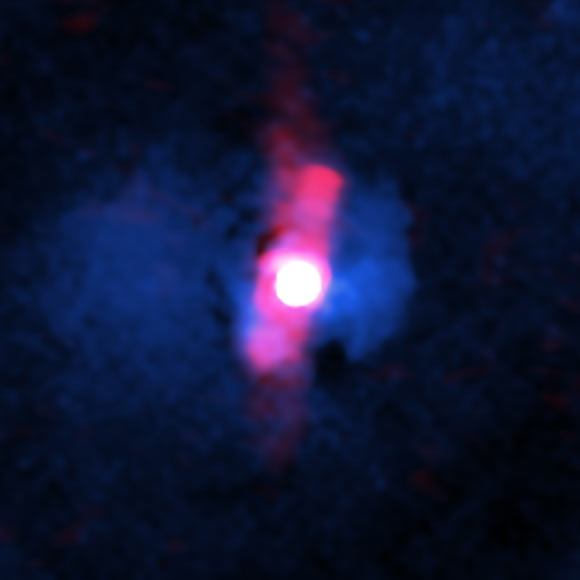Using NASA’s Chandra X-ray Observatory and NSF’s Karl G. Jansky Very Large Array (VLA), astronomers have found that H1821+643 — the nearest quasar hosted by a galaxy cluster, at a distance of about 3.4 billion light-years — is less influential than many giant black holes in other galaxy clusters.
This composite image shows the quasar H1821+643. Image credit: NASA / CXC / University of Nottingham / Russell et al. / NSF / NRAO / VLA / SAO / N. Wolk.
Quasars are a rare and extreme class of supermassive black holes that are furiously pulling material inwards, producing intense radiation and sometimes powerful jets.
Known as H1821+643, this quasar is about 3.4 billion light-years from Earth and contains a 4-billion-solar-mass black hole.
Most growing supermassive black holes pull material in less quickly than those in quasars.
Astronomers have studied the impact of these more common black holes by observing ones in the centers of galaxy clusters.
Regular outbursts from such black holes prevent the huge amounts of superheated gas they are embedded in from cooling down, which limits how many stars form in their host galaxies and how much fuel gets funneled toward the black hole.
Much less is known about how much influence quasars in galaxy clusters have on their surroundings.
“We have found that the quasar in our study appears to have relinquished much of the control imposed by more slowly growing black holes. The black hole’s appetite is not matched by its influence,” said Dr. Helen Russell, an astronomer at the University of Nottingham.
To reach this conclusion, Dr. Russell and colleagues used Chandra to study the hot gas that H1821+643 and its host galaxy are shrouded in.
The bright X-rays from the quasar, however, made it difficult to study the weaker X-rays from the hot gas.
“We had to carefully remove the X-ray glare to reveal what the black hole’s influence is. We could then see that it’s actually having little effect on its surroundings,” said Dr. Paul Nulsen, an astronomer at the Harvard & Smithsonian’s Center for Astrophysics.
Using Chandra, the astronomers found that the density of gas near the black hole in the center of the galaxy is much higher, and the gas temperatures much lower, than in regions farther away.
They expect the hot gas to behave like this when there is little or no energy input (which would typically come from outbursts from a black hole) to prevent the hot gas from cooling down and flowing toward the center of the cluster.
“The giant black hole is generating a lot less heat than most of the others in the centers of galaxy clusters. This allows the hot gas to rapidly cool down and form new stars, and also act as a fuel source for the black hole,” said Dr. Lucy Clews, an astronomer at the Open University.
The researchers determined that hot gas — equivalent to about 3,000 times the mass of the Sun per year — is cooling to the point that it is no longer visible in X-rays.
This rapid cooling can easily supply enough material for the 120 solar masses of new stars observed to form in the host galaxy every year, and the 40 solar masses consumed by the black hole each year.
The scientists also examined the possibility that the radiation from the quasar is directly causing the cluster’s hot gas to cool down.
This involves photons of light from the quasar colliding with electrons in the hot gas, causing the photons to become more energetic and the electrons to lose energy and cool down.
The study showed that this type of cooling is probably occurring in the cluster containing H1821+643 but is much too weak to explain the large amount of gas cooling seen.
“While this black hole may be underachieving by not pumping heat into its environment, the current state of affairs will likely not last forever,” said Dr. Thomas Braben, an astronomer at the University of Nottingham.
“Eventually the rapid fuel intake by the black hole should increase the power of its jets and strongly heat the gas.”
“The growth of the black hole and its galaxy should then drastically slow down.”
The team’s paper will be published in the Monthly Notices of the Royal Astronomical Society.
_____
H.R. Russell et al. 2024. A cooling flow around the low-redshift quasar H1821+643. MNRAS, in press; arXiv: 2401.03022


